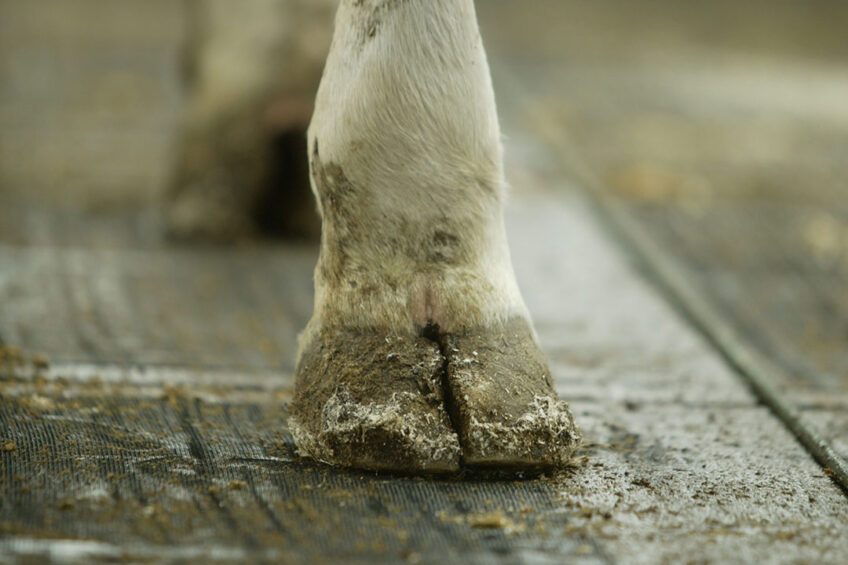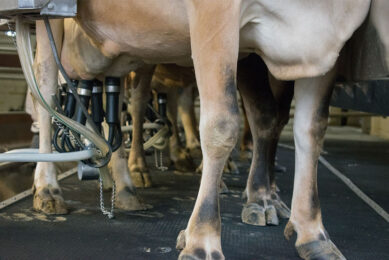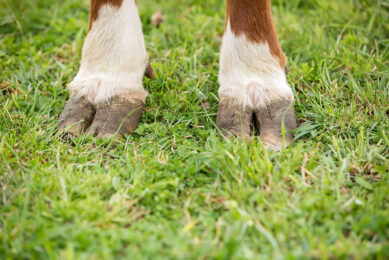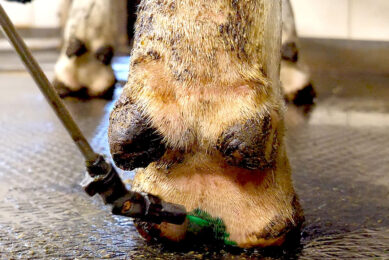What you need to know about hoof over-trimming in dairy cows

Hoof trimming is essential in caring for dairy cows and plays an important role in preventing lameness. But what happens when hoof over-trimming takes place? Two experts reveal what to do to prevent this from happening.
It can happen – a hoof trimmer can over-trim a cow’s hoof. Usually trimming occurs twice a year but the presence of infectious diseases can increase the need for hoof trimming, according to the University of Kentucky.
For hooves with overgrown toes, a heel with a compromised structure will be more susceptible to bacterial invasion. Sticking to scheduled trimming visits is as important as maintaining proper procedures and exercising caution when doing so. There should also be no leeway for poor trimming, which can lead to major health issues.
Nathan Ranallo of Ranallo Hoof Care, a professional hoof trimmer based in Wisconsin, US, says that while over-trimming does occur, it isn’t a common occurrence. It is more common to misunderstand what the effects are of trimming on the rate at which a hoof wears.
According to Ranallo, “certain trimming techniques can increase the rate of wear, and it’s those effects that are often seen as over-trimming.” He says that removing heel depth on the lateral claw in an attempt to “balance” the claws is the chief culprit of over-wearing. Because the lateral heel (on rear feet) bears the brunt of heel strike and maximum pressures, lowering it too far amplifies those pressures and increases the rate at which it wears, Ranallo notes, adding that this can cause the medial claw to wear more and after a couple of weeks the cow can be left with thin soles.
Considerations to avoid hoof over-trimming
There is no doubt that exercising caution plays an important role when it comes to scheduled trimming. Ranallo adds, “Removing a large portion of the heel in the form of modelling can also increase the rate of wear, and decreasing the surface area of the heel will cause the remaining area to wear faster.”
Therefore, it is important to note that being cautious certainly pays off, particularly for the inexperienced trimmer. Ranallo recommends that the less experienced hoof trimmer “should always err on the side of caution” and leave plenty of sole thickness. “You can always remove more but you can’t put hoof back,” he says.
Maintaining the horn in certain areas should be top of mind, too, for trimmers. based in the UK, Sara Pedersen, Royal College of Veterinary Surgeons-recognised specialist in cattle health and production, says: “It’s really important to maintain horn in areas where we need it to protect the underlying soft tissues from the concussive forces as the foot strikes the ground. Thin soles result from removing too much horn from the soles and usually coincide with over-shortening of the toe as well. Removing too much horn from the heel area can also compromise heel height and therefore foot angle, too, placing more of the cow’s weight through the rear of the foot where the pedal bone is less stable.”
‘Foot check’ instead of ‘foot trim’
Not all farms are the same; what works for one farm may not be the right way to operate another. This aspect should not be overlooked by trimmers, as the trimming technique or good hoof trimming plan is essential and should fit with each individual farm. Think of how the farm is run – is it a high-wear environment with sand-bedded herds? Or does the farm have grazing herds that are walking long distances, which will impact the trimming session technique? “Recycled sand bedding, new concrete, long walking distances, etc., can increase the rate of wear as well, so lower wear techniques should be used in these situations,” says Ranallo.
Being aware of your herds’ hooves is the way forward. The Agriculture and Horticulture Development Board (AHDB) agrees that when a cow is scheduled for a procedure, it is still important to recognise when a hoof does not need trimming. According to Pedersen, in some instances there is no horn to take off – it can be hard to recognise that not every foot needs to be trimmed, and therefore it is perhaps better to think of ‘foot check’ instead of ‘foot trim’. This way there is little chance of trying to correct a situation when it could have been prevented in the first place.
Going forward
Pedersen says that there has been a need to update and adapt the approach of previous years. The current best practice recommendation is still based on the original Dutch Five-Step Method but with a few alterations, such as increasing toe length to account for the increase in the size of modern Holsteins. She adds that where there is over-trimming “due to a move away from best practice technique then it is important to undergo retraining to ensure any errors or habits that have crept in are rectified”. She advises that regular assessments are undertaken to ensure that standards are met and maintained.










